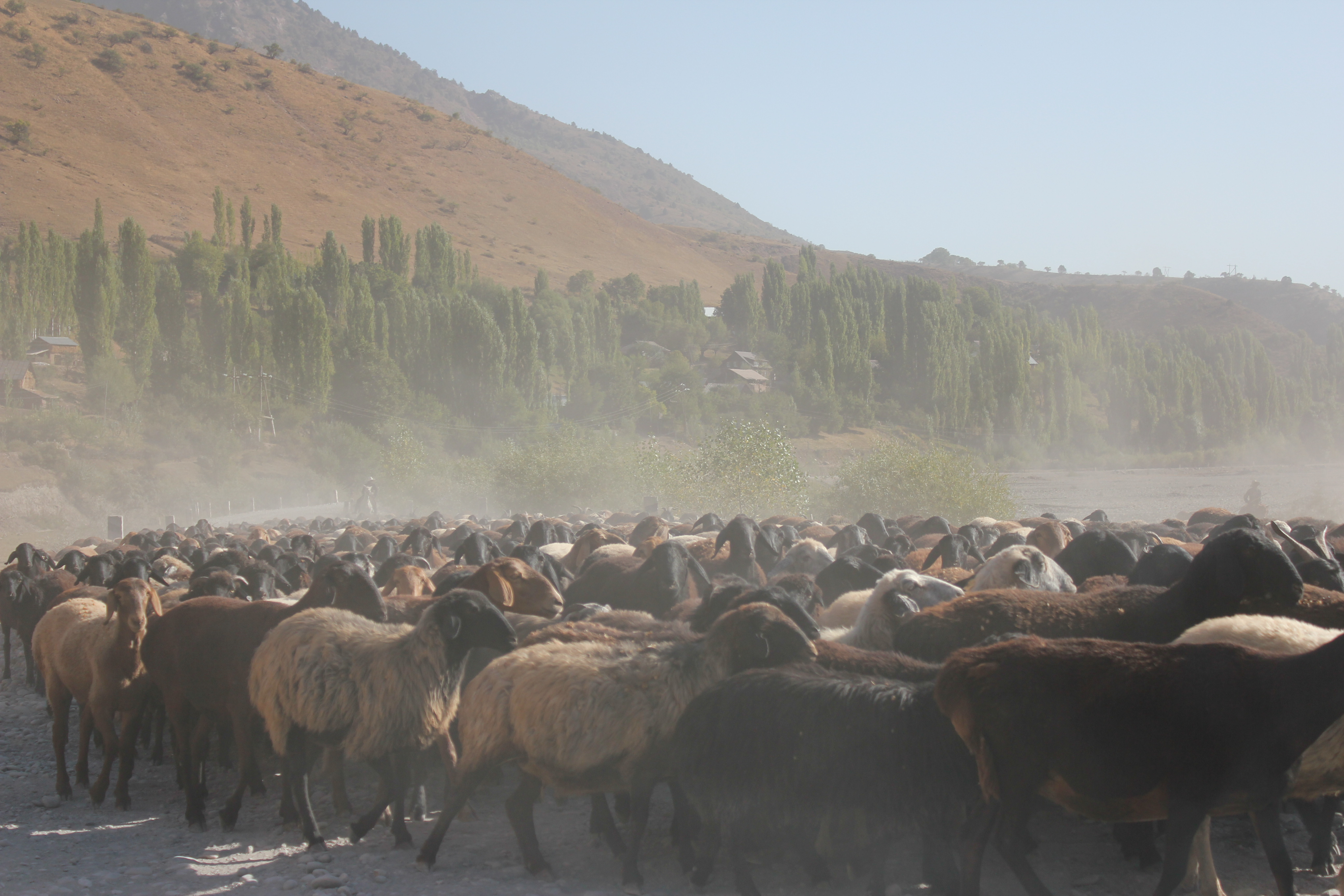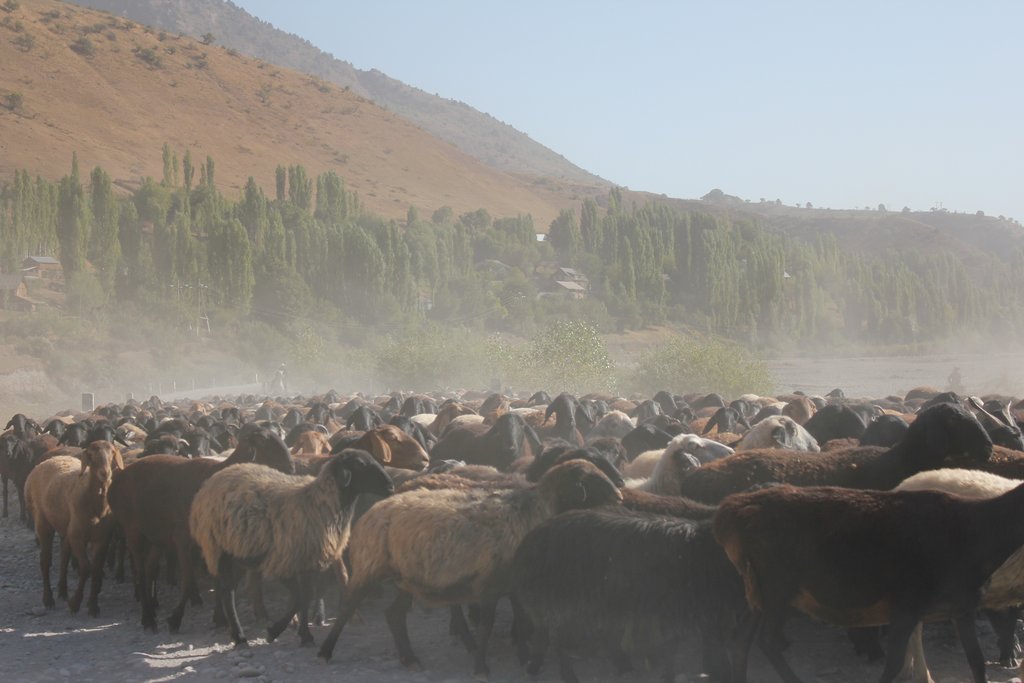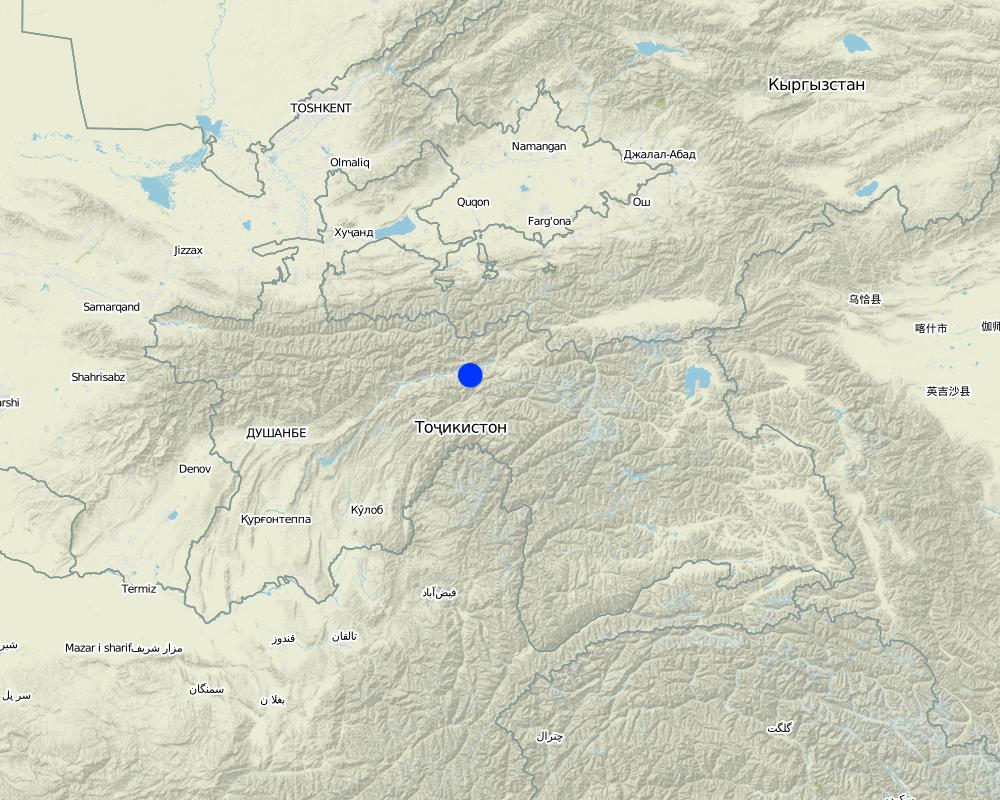Herds movement and roaming at different altitude/watershed zone [Tadjikistan]
- Création :
- Mise à jour :
- Compilateur : Askarsho Zevarshoev
- Rédacteur : –
- Examinateur : Farrukh Nazarmavloev
Бурдани чорво ба чарогоххои дур
approaches_3630 - Tadjikistan
Voir les sections
Développer tout Réduire tout1. Informations générales
1.2 Coordonnées des personnes-ressources et des institutions impliquées dans l'évaluation et la documentation de l'Approche
Nom du projet qui a facilité la documentation/ l'évaluation de l'Approche (si pertinent)
Environmental Land Management and Rural Livelihoods (ELMAR)1.3 Conditions relatives à l'utilisation par WOCAT des données documentées
Quand les données ont-elles été compilées (sur le terrain)?
11/03/2018
Le compilateur et la(les) personne(s) ressource(s) acceptent les conditions relatives à l'utilisation par WOCAT des données documentées:
Oui
2. Description de l'Approche de GDT
2.1 Courte description de l'Approche
In this approach community take the opportunity to move their livestock along different pasture resources, which are located at different altitude. This is appropriate in mountains areas, where vegetation period starts in different period and community have access to fresh fodder for their animals. At this time they have the chance to save the pasture close to the village and crop land which they cultivate during summer time.
2.2 Description détaillée de l'Approche
Description détaillée de l'Approche:
In the mountain areas of Tajikistan pasture are distributed according to the seasonal use named also accordingly – winter/spring pasture and summer pasture. The winter pasture are usually are located in the upper zone of the watershed, while the winter/spring pasture are the one close to the community. Based on this delineation they are used in different season, because in the early spring, when snow just started melting in the close pasture in the remote pasture it is still covered by snow and not possible go to this areas. In this way community provide balance in use of pasture resource between different types of pasture resources along different altitude.
The approach is applied in a participatory way in agreement with all involved stakeholders, including community members/livestock owners, local government and other involved parties, such as herder from other communities. Community jointly in a village meeting in the early season of grazing plan for herds movements and assign responsible people with support of the village management to organize logistics.
Community is very much in favor to organize in such approach to move their animal to other places when at this period they save fodder and easily cultivate their crops land in the village. The only thing they do not like is that during this period they do not have to the dairy product, which could they get from their animals.
2.3 Photos de l'approche
Remarques générales concernant les photos:
Community build special sheds in the pasture, where the livestock is kept during night time or when there is heavy rainy days. Sometimes, in the remote pasture community build similar but closed, which is also a mean to protect from wild animal, such as bear and wolf and sometime snow leopards.
2.5 Pays/ région/ lieux où l'Approche a été appliquée
Pays:
Tadjikistan
Région/ Etat/ Province:
Rasht Vally, Lakhsh District
Commentaires:
The shed, which is called kashar in local language is a traditional approach, which is constructed jointly by community efforts, but sometime external funding also support with construction as part of pasture infrastructure development
Map
×2.6 Dates de début et de fin de l'Approche
Si l'année précise est inconnue, indiquez approximativement quand l'Approche a démarré:
il y a plus de 50 ans (technologie traditionnelle)
Commentaires:
The approach is traditional way of movement herds along the pasture, while living in mountain communities.
2.7 Type d'Approche
- traditionnel/ autochtone
2.8 Principaux objectifs de l'Approche
The main goal of this approach is to balance the availability of pasture resources availalbe for community to gain maximum benefit from existing fodder source in the surrounding areas.
2.9 Conditions favorisant ou entravant la mise en œuvre de la(des) Technologie(s) appliquée(s) sous l'Approche
normes et valeurs sociales/ culturelles/ religieuses
- favorise
this is traditional approach and community members knowledge on this is transferred from generation to generation and does not have any limitation from social/cultural point of view. In fact traditionally the older generation is motivating youth to use the approach in order to use their pasture resource sustainably.
disponibilité/ accès aux ressources et services financiers
- favorise
usually not much financial resource is required to implement the resource. The only this is need to organize community and manage their resource sustainably.
cadre institutionnel
- favorise
traditional institutions, which deal with natural resource management exist from very beginning. When community motivated to establish their official institutions such as Pasture User Unions this is also enables community to plan according to the approach to move the herd from one pasture area to another during different season.
collaboration/ coordination des acteurs
- favorise
traditional all members of community is involved and aware of the approach, and also when official legal institute is established it also bring all stakeholder to plan for pasture grazing in a participatory way
cadre juridique (régime foncier, droits d'utilisation des terres et de l'eau)
- favorise
in a traditional way when applying the approach community know, which part of the pasture they own and plan accordingly, while when the official legal institute is established, such as PUU they obliged to gain certificate, which recognize their land use rights.
gouvernance foncière (prise de décisions, mise en œuvre et application des décisions)
- favorise
the approach is discussed in a participatory way among community members and agreed to implement accordingly.
connaissances sur la GDT, accès aux supports techniques
- favorise
this is traditional knowledge which is transfered from one generation to another generation, however when applied in the framework of project special technical team is assigned to support communities with implementation.
3. Participation et rôles des parties prenantes impliquées dans l'Approche
3.1 Parties prenantes impliquées dans l'Approche et rôles
- exploitants locaux des terres / communautés locales
community members, livestock owners
support with explaining the approach based on their traditional knowledge and provide evidence based information from their experiences
- organisations communautaires
village organization, traditional community structures
guide community members and livestock owners on planing and implementing the approach.
- Spécialistes de la GDT/ conseillers agricoles
project technical team, specialist from respective research institutes, such as livestock institute
support with applying the technical aspect of the approach and awareness raising on the approach from science point of view.
- gouvernement local
respective local government departments, such as land committee, forestry department
supervise the implementation process and guide in applying the approach within framework
3.2 Participation des exploitants locaux des terres/ communautés locales aux différentes phases de l'Approche
| Participation des exploitants locaux des terres/ communautés locales | Spécifiez qui était impliqué et décrivez les activités | |
|---|---|---|
| initiation/ motivation | auto-mobilisation | traditionally community are used to apply approach every time when the season for grazing comes |
| planification | auto-mobilisation | existing community structure in the mountains areas come together in a community meeting to discuss and develop the plan for pasture use, which entails also applying the approach |
| mise en œuvre | interactive | usually community organize gathering dates for moving the herd, assign responsible person and agree with other stakeholders or pasture users from neighbor communities. |
| suivi/ évaluation | passive | very passive monitoring is applied in monitoring the approach results and almost no research is involved. |
3.4 Prises de décision pour la sélection de la Technologie/ des Technologies
Indiquez qui a décidé de la sélection de la Technologie/ des Technologies à mettre en œuvre:
- principalement les exploitants des terres soutenus par des spécialistes de la GDT
Expliquez:
mainly land users plan for applying the approach, only sometimes when any project implemented in the area the technical team is involved and sometime supported with specialist from local government
Spécifiez sur quelle base ont été prises les décisions:
- expériences et opinions personnelles (non documentées)
4. Soutien technique, renforcement des capacités et gestion des connaissances
4.1 Renforcement des capacités/ formation
Une formation a-t-elle été dispensée aux exploitants des terres/ autres parties prenantes?
Non
4.2 Service de conseils
Les exploitants des terres ont-ils accès à un service de conseils?
Oui
Spécifiez si le service de conseils est fourni:
- dans les champs des exploitants?
Décrivez/ commentez:
government officials usually control the movement of the herd to the remote pasture, especially when there is crop season in the village.
4.3 Renforcement des institutions (développement organisationnel)
Des institutions ont elles été mises en place ou renforcées par le biais de l'Approche?
- oui, modérément
Spécifiez à quel(s) niveau(x), ces institutions ont été renforcées ou mises en place:
- local
Décrivez l'institution, ses rôles et responsabilités, ses membres, etc.
mainly traditional village level structure, which include all community members and leaders to plan for village development. sometime supported by local government to enforce the implementation of the approach in order not to effect the crop production in the village/community.
4.4 Suivi et évaluation
Le suivi et l'évaluation font ils partie de l'Approche? :
Oui
Commentaires:
very few monitoring is done, usually by the officials of local government from agriculture department to make sure that the livestock is moved to the remote pasture and there is no grazing applied in the crop lands
Si oui, ce document est-il destiné à être utilisé pour le suivi et l'évaluation?
Non
Commentaires:
only reported by the government and from community to the head of the village organization
4.5 Recherche
La recherche a-t-elle fait partie intégrante de l’Approche?
Non
5. Financement et soutien matériel externe
5.1 Budget annuel de la composante GDT de l'Approche
Si le budget annuel précis n'est pas connu, indiquez une fourchette:
- < 2 000
Commentez (par ex. principales sources de financement/ principaux bailleurs de fonds):
mainly from community of provision of vehicle and other source for infrastructure development, but some projects are also have contributing in construction of the infrastructure, including Environmental Land Management and Rural Livelihoods Project
5.2 Soutiens financiers/ matériels fournis aux exploitants des terres
Les exploitants des terres ont-ils reçu un soutien financier/ matériel pour la mise en œuvre de la Technologie/ des Technologies?
Non
5.3 Subventions pour des intrants spécifiques (incluant la main d'œuvre)
- aucun
Si la main d'œuvre fournie par les exploitants des terres était un intrant substantiel, elle était:
- volontaire
Commentaires:
no construction work is required to implement the approach, only organization and management capacity is needed for community to apply the approach.
5.4 Crédits
Des crédits ont-ils été alloués à travers l'Approche pour les activités de GDT?
Non
5.5 Autres incitations ou instruments
D'autres incitations ou instruments ont-ils été utilisés pour promouvoir la mise en œuvre des Technologies de GDT?
Oui
Si oui, spécifiez:
development of the community plan, which mobilize and give incentives to implement the approach
6. Analyses d'impact et conclusions
6.1 Impacts de l'Approche
Est-ce que l'Approche a autonomisé les exploitants locaux des terres, amélioré la participation des parties prenantes?
- Non
- Oui, un peu
- Oui, modérément
- Oui, beaucoup
it brings all community members, which own livestock and motivate them join management of their resources.
Est-ce que l'Approche a construit/ renforcé les institutions, la collaboration entre parties prenantes?
- Non
- Oui, un peu
- Oui, modérément
- Oui, beaucoup
while the approach bring all stakeholders together to plan and manage their resource it also strengthens collaboration among them and improves their institutions.
Est-ce que l'Approche a atténué les conflits?
- Non
- Oui, un peu
- Oui, modérément
- Oui, beaucoup
the approach enables to agree and communicate the movement of the herd, which does not interfere into the other community areas.
Est-ce que l'Approche a autonomisé les groupes socialement et économiquement défavorisés?
- Non
- Oui, un peu
- Oui, modérément
- Oui, beaucoup
the approach is very inclusive and does not discriminate in participation of all groups. Those of who own livestock are equally participate
Est-ce que l'Approche a encouragé les jeunes/ la prochaine génération d'exploitants des terres à s'engager dans la GDT?
- Non
- Oui, un peu
- Oui, modérément
- Oui, beaucoup
the approach is used to be traditional and both youth and women are involved in promoting and implementing it.
6.2 Principale motivation des exploitants des terres pour mettre en œuvre la GDT
- augmenter la production
when movement along all the pasture zone is taken place, this will lead burden to other parts and improved productivitiy
- augmenter la rentabilité/ bénéfice, rapport coûts-bénéfices
research results from other projects shows that movement among different types of pasture create an opportunity to use the potential production of pasture and get maximum increase in livestock productivity
- réduire la dégradation des terres
the approach in movement from one part to another place in the pasture leave space for the plot to fallow and regenerate
- atténuer les conflits
6.3 Durabilité des activités de l'Approche
Les exploitants des terres peuvent-ils poursuivre ce qui a été mis en œuvre par le biais de l'Approche (sans soutien extérieur)?
- oui
Si oui, décrivez de quelle manière:
traditionally the knowledge on the approach is transferred from generation to generation, which guarantees the sustainability, in addition local government is involved to control and supervise the herd movement among different pasture types according to the season.
6.4 Points forts/ avantages de l'Approche
| Points forts/ avantages/ possibilités du point de vue de l'exploitant des terres |
|---|
| traditional knowledge, simple and effective in livestock management and increasing production |
| Points forts/ avantages/ possibilités du point de vue du compilateur ou d'une autre personne ressource clé |
|---|
| compliant to the concept of pasture grazing between different areas |
| supported and motivated by government in order to control both the crop production and livestock production |
6.5 Faiblesses/ inconvénients de l'Approche et moyens de les surmonter
| Faiblesses/ inconvénients/ risques du point de vue de l’exploitant des terres | Comment peuvent-ils être surmontés? |
|---|---|
| when the livestock is moved to remote pasture the owners does not have access or limited access to dairy product | if the pasture infrastructure is well developed it will enable community and also herder to bring the dairy product to the village to sell and process |
| Faiblesses/ inconvénients/ risques du point de vue du compilateur ou d'une autre personne ressource clé | Comment peuvent-ils être surmontés? |
|---|---|
| very few monitoring is applied | community capacity should be build to monitor the implementation of the approach |
| research is not involved to recognize the effect of movement | collaboration between communities and research institute to establish and support government to mobilize research institutes |
7. Références et liens
7.1 Méthodes/ sources d'information
- interviews/entretiens avec les exploitants des terres
various from community to community
- interviews/ entretiens avec les spécialistes/ experts de GDT
3
7.2 Références des publications disponibles
Titre, auteur, année, ISBN:
Pasture and Livestock Management Plan, Askarsho Zevarshoev, 2014
Disponible à partir d'où? Coût?
Free, from compiler
Liens et modules
Développer tout Réduire toutLiens
Aucun lien
Modules
Aucun module trouvé





